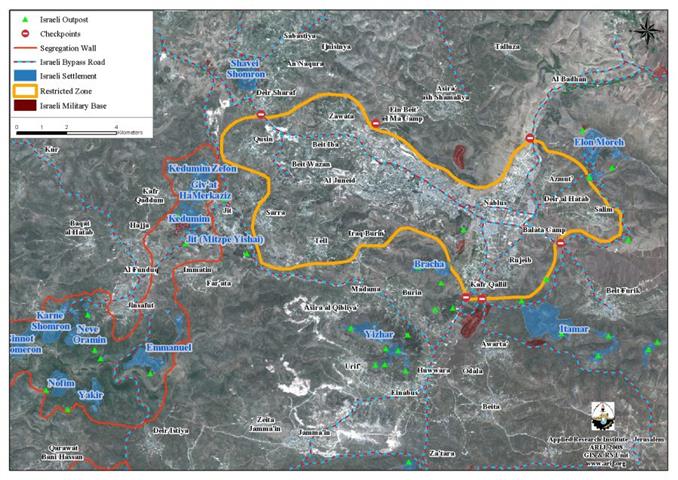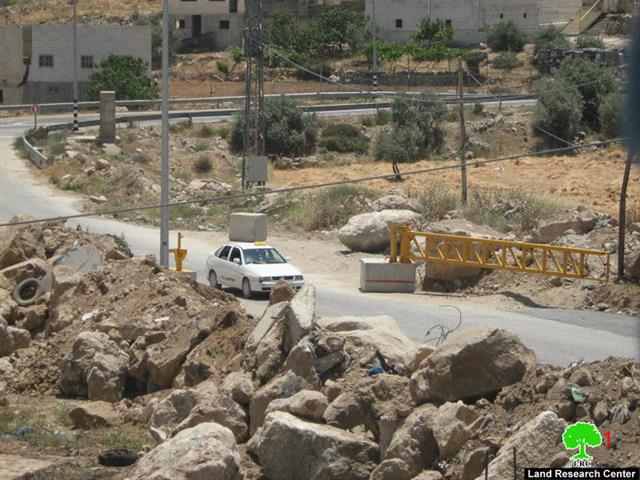A new Israeli military order signed by the commander of the Israeli defense forces in Judea and Samaria, major General Ya'eir Neve Alof, on the 19th of April 2007, (Order with regard to security instruction 'Judea and Samaria' number 378 of the year 1970) officially declares Nablus city and 15 other Palestinian villages around it as 'Siege Area'. The order also assigned 6 main Israeli checkpoints (crossing points) to control the ins and outs of Palestinians living in those 16 communities. The 'siege area' includes the following communities: Zuwwata, Qusin, and Nablus city, Beit Iba, Beit Wazan, 'Azmout, Al Juneid, Deir Hatab, Salem, Sarah, Askar Camp, Balata Camp, Tal, Iraq Burin, Rojeib and Kafr Qalil. The 15 villages and Nablus city houses a total population of more that 220 Palestinians (PCBS 2007). See Map 1
The 'siege area' is considered one of the most areas targeted by the Israeli military checkpoints in the West Bank as the number of checkpoints along the borders of the siege area is twenty. The issuance of the military order came as a response to the pressure exerted by the Quartet's envoy, Tony Blair and the U.S reports which stressed out the need to ease the siege on Nablus city and the surrounding villages; the number of Israeli checkpoints was actually reduced as stated in the military order, but on the ground, the 20 Israeli checkpoints are still controlling the area and obstructing the movement of hundreds of Palestinians crossing the checkpoints daily.
Content of the Military Order
The Military Order hinders the entry and exit of any Palestinian vehicle to and from the 'siege area' without a permit issued by the commander of IDF forces or any other official authorized by him. The order also states that the entry and the exit of any person to and from the 'siege area' is through the six Israeli checkpoints assigned on the attached map. See Map 2
Map 2: Map of the Military Order
Effects of the Military Order:-
The Israeli Military order comes to impose siege on the city of Nablus and the surrounding villages as such, since the eruption of the second Intifada in September 2000, the Israeli Occupation Forces targeted Nablus Governorate in particular; and despite the fact that all West Bank Governorates were put under siege, the situation in Nablus Governorate was completely different as Israel continued to tighten the siege for the 8th year on row which severely affected the lives of its residents on all levels. The following are the names of the main Israeli checkpoints in Nablus Governorate: Huwwara checkpoint to the south of Nbalus city, At Tur Checkpoint, Za'tara and 'Awarta Checkpoints to the south and southwest of Nablus city, Beit Iba and 'Asira Ash Shamaliyeh checkpoints to the northwest of Nablus city, Beit Furik Checkpoint to the east of Nablus city, Shavei Shomron Checkpoint which is the only link between Nablus and Jenin Governorates and is located to the northwest of Nablus city, and Ma'ale Efrayim Checkpoint which connects Nablus Governorate with Jericho and is located to the east of Nablus city.
Switching to Border Crossings
Nowadays, the Israeli Occupation Forces are fortifying the Israeli checkpoints surrounding the city of Nablus to further become like border crossings. During the last month, the Israeli Bulldozers razed about 10 dunums of lands in the vicinity of Huwwara checkpoint and the supplied it with cement blocks to further control the vehicular and pedestrian movement of Palestinians living in the 'siege area'; The IOF also started working on changing the status of Beit Iba checkpoint to become like a border crossing and supplied it with very advanced security and inspection systems and handled the access responsibility to a private Israeli security company. It was also reported that the IOF also close Beit Iba checkpoint from time to time, the last of which was on the 8th of May, 2008, when the IOF closed the checkpoint to provide security to Israeli settlers who hiked towards the evacuated Homesh Settlement celebrating the 60th anniversary of Israel's Independence Day.
To Conclude
By issuing the military order, Israel has actually proved its good intentions internationally; but it didn't recognize the minimum needs of Palestinians as checkpoints are still a form of obstruction and humiliation to Palestinians all over the West Bnak Territory and are considered as a violation to International human Rights conventions, as in Article 12 of the International Covenant on Civil and Political Rights which states that ''Everyone lawfully within the territory of a State shall, within that territory, have the right to liberty of movement and freedom to choose his residence''.
Prepared by
The Applied Research Institute – Jerusalem
















